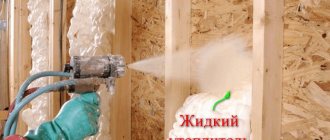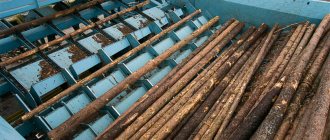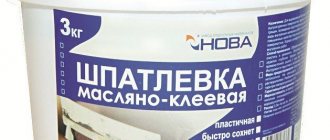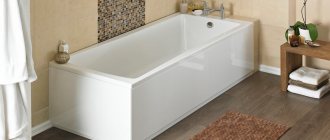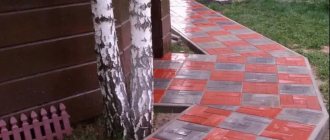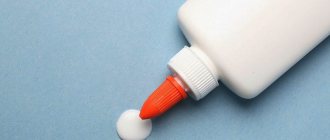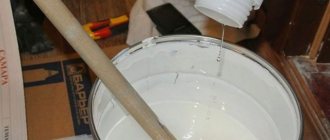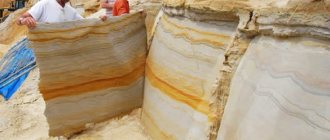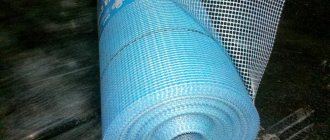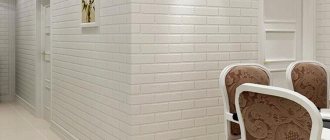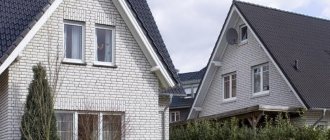Foam density is an indicator that determines the strength characteristics of thermal insulating polystyrene foam. This thermal insulation material consists of 98% air bubbles and 2% pure polystyrene. Polystyrene is the basis of expanded polystyrene.
It is obtained by the polymerization of styrene. Expanded polystyrene has become widespread due to a number of advantages:
- No toxic compounds.
- High thermal insulation properties, thermal conductivity in a dry state – 0.029-0.036 W/(m.k).
- Light weight.
- Polystyrene foam does not enter into chemical reactions with building materials (cement, bitumen, acrylic, gypsum putty).
- Resistance to microorganisms, algae, mold, fungus.
- Durability.
The physical and mechanical properties of polystyrene foam may vary. They depend on the quality of the raw materials and the method of polymerization of styrene.
What is polystyrene foam and important characteristics of the material
Expanded polystyrene is understood as a gas-filled material based on polystyrene, its derivatives and styrene copolymers. The product is produced by foaming a molten polymer mass consisting of styrene granules with a low-boiling hydrocarbon liquid - pentane, isopentane or dichloromethane. At the end, the material is molded to produce slabs, in which the finished product is produced.
What colors is polystyrene foam available in?
The main form of production is sheets with dimensions of 1000x1000, 1000x1200, 2000x1000, 2000x1200 mm. Thickness varies between 20-100 mm. Expanded polystyrene has a cellular structure. Solid matter in it occupies only 2%, while 98% is allocated to voids. They are miniature polystyrene chambers (cells) with air inside. They are the ones who ensure the waterproofness of the material. Among other characteristics of expanded polystyrene it is worth noting:
- Vapor permeability is 0.05 mg/m·year·Pa (virtually vapor-tight). Steam does not penetrate into extruded polystyrene foam at all, since the material is not cut - it is released from the extruder in the form of finished slabs.
- Density – 10-50 kg/m3. It is used to determine the grades of material - according to GOST-15588-86, polystyrene foam is classified as 15, 25, 35 and 50.
- Static bending strength – 0.02-0.2 kg/cm2.
- Thermal conductivity – λ = 0.028-0.038 W/m·K. The higher the density of the foam , the higher the degree of thermal insulation.
- Daily water absorption by volume is up to 2%. Dense polystyrene foam, made by extrusion, practically does not absorb water at all - it absorbs 10 times less than ordinary polystyrene foam.
Please note: for heated floors, it is optimal to use foil polystyrene foam. It significantly increases the insulating properties of the material.
The properties of expanded polystyrene are determined by its structure
Application area
Foam insulation can be found in various sectors of the national economy. They are used, for example, for thermal insulation of freezers, refrigerators, isothermal vans, etc. In construction they use for insulation:
- facades, which allows you to solve several problems at the same time: create effective thermal insulation of the building; protect walls from rain, wind, sunlight and temperature changes; remove the “dew point” from the thickness of the wall, preventing it from freezing (very important for brick and ceramics);
- floors - used for insulation using the “floating screed” method;
- roofs (roofs) - laid on the back side of the roof (“Ventilated roof”) and on top (“Non-ventilated roof”);
- foundations;
- ceiling (interfloor ceiling);
- walls from the inside of the premises, balconies, loggias, garages, workshops and other utility or utility rooms;
- pipelines.
Foam plastic is also increasingly used in the installation of permanent formwork during the construction of monolithic buildings.
Types of expanded polystyrene and their designation
In the product designation you can find different letters, by which it is easy to determine the type of polystyrene foam. It is standardly labeled as “PS”. Depending on the product brand, other letters and numbers are added to them. There are different types of polystyrene foam:
- Pressless (PSB, PSB-S - self-extinguishing type). It is not subjected to pressure during manufacturing. Polystyrene granules are simply dried at 80 °C and then foamed. This is repeated several times, and then the product is left to cool. It turns out to be more compact, and due to the reduction in the volume of pentane used, it is cheaper.
Pressless expanded polystyrene
- Extruded (XPS, Extruded Polystyrene). Produced by extrusion - passing through a molding hole. Its main advantage is absolute waterproofness. It is known on the market under such brands as Technoplex, Penoplex, TechnoNIKOL, URSA XPS. Due to low vapor permeability and flammability, it is used to insulate underground structures and facades.
Extruded polystyrene foam
- Press (PS). By pressing it is possible to obtain a more dense and durable material, although in terms of the degree of thermal insulation it is no different from non-pressed material. The material is not widely used because its production is more difficult and expensive.
Pressed polystyrene foam
- Autoclave. Produced by the American company Dow Chemical Company, marketed under the generic name Styrofoam.
We advise you to study in more detail: “Everything about XPS extruded polystyrene foam: composition, characteristics, pros and cons, review of manufacturers.”
Brands of pressless polystyrene foam - how to choose the right one
Today, the most common type is non-pressed polystyrene foam. When choosing which foam plastic to use for thermal insulation, you need to take into account its types, which are distinguished by density:
- PSB-15. Foam with the lowest density. It is used where special mechanical strength is not required from the insulation, for example, for thermal insulation of cars, attics or pitched roofs. Not suitable for the internal layer of external walls and facades of permanent residential buildings.
- PSB-25. It is considered the most popular and even universal brand. Relevant for insulating facades, loggias, walls, floors. Additionally, it can be used as sound insulation.
- PSB-35. A material with an already increased density, which allows it to be used for insulating underground structures and foundations. Another area of application is the production of sandwich panels, as well as the creation of permanent formwork from polystyrene foam .
- PSB-50. The brand with the highest density, used where there are strict requirements for the mechanical strength of the insulation. This is the construction of interfloor ceilings, the construction of roads in swampy areas, the installation of floors in a garage or industrial facilities, including refrigeration facilities.
The difference in characteristics of the listed types of polystyrene foam boards is presented in the table:
| Brand of slabs | ||||
| An indicator for comparing different brands of slabs | PSB-15 | PSB-25 | PSB-35 | PSB-50 |
| Material density, kg/m3 | up to 15 | 15-25 | 25-35 | 35-50 |
| Compressive strength at 10% of linear deformation, MPa | 0,07-0,15 | 0,15-0,18 | 0,18-0,26 | 0,26-0,38 |
| Bending strength, MPa | 0,15-0,23 | 0,32 | 0,30-0,38 | 0,38-0,42 |
| Thermal conductivity at a temperature of 25±5 °C and normal relative humidity, W/(m K) | 0,032-0,036 | 0,029-0,033 | ||
| Humidity of slabs, % | 2 | |||
Rules for choosing polystyrene foam for facade insulation
PSB-S-25 foam is best suited for façade insulation. There are several reasons for this:
- this material has sufficient density and strength for installation on any supporting base;
- has a degree of thermal conductivity low enough to prevent heat loss from the interior;
- is light in weight;
- easy to transport;
- is characterized by low cost;
- self-extinguishing;
- durable.
Foam plastic for facade insulation
The most important indicator of the quality of PPP is density. It depends on the production method and the characteristics of the foam granules. During sintering, polystyrene foam granules swell; when pressed, they stick together. The stronger the pressing, the tighter the granules adhere to each other. The degree of thermal conductivity and vapor permeability of the product at the outlet directly depends on this.
What's bad about low-density foam?
With a low density of EPS, its structure is relatively loose, since the distance between the granules is significant. These gaps are the reason for the good vapor permeability of the material. But the polystyrene foam granules themselves, due to their higher density than the air between them, allow steam to pass through much worse.
This leads to the accumulation of moisture inside the insulation, which is removed more slowly than required. As a result, the plaster applied to the foam will attract moisture and gradually deteriorate. The same can be said about other materials adjacent to the insulation, or located next to it. Therefore, it is so important to make sure that the foam purchased in the store is of sufficiently high density.
What is sold under the brand name PSB-25
The high demand for polystyrene foam has led to the emergence of a large number of large and small manufacturers and distributors of polystyrene foam on the market. They all understand that this material is chosen as insulation primarily due to its low price. This fact, coupled with high competition, forces manufacturers to win back their market segment by reducing prices, which cannot but affect the quality of their products.
For this reason, the situation on the market is such that under the PSB-25 brand they sell products whose quality does not stand up to criticism. This also applies to foam plastics of other popular brands.
Video - Polystyrene foam PSB-S 25 TU and foam plastic PSB-S 35 TU
It is important to know: for many years, the production of polystyrene foam has not been standardized by GOST to the extent necessary. Each enterprise that manufactures PPP develops its own technical specifications (TS) regulating the technological process. This gives the owner of the enterprise freedom of action, and he has every right not to comply with previously adopted standards.
Foam production diagram
The need to reduce the price of the finished product forces the manufacturer to reduce the cost of the material. GOST according to PSB-25 allows the production of a product with a density of 15 to 25 kg/m3 under this brand.
This has led to the fact that building materials stores under the PSB-25 brand offer foam plastic, the density of which is significantly lower than 25 kg/m3. But, as mentioned above, this is not consumer deception. This is permitted by the standards body.
How to find out the density of foam plastic
How to determine the density of foam plastic
The density of PPS is calculated as follows: 1 m3 of this material is weighed. The resulting value is an indicator of density. That is, 1 m3 of PSB-25 should weigh 25 kg. In practice this is extremely rare.
The most common situation is that foam plastic with a density of 16.1-16.5 kg/m3 is sold under this brand. You can check the density of the sample directly at the retail outlet where it is purchased.
As a rule, all building materials stores or market pavilions are equipped with equipment for weighing goods. It is necessary to take a sheet of foam plastic of the required thickness and calculate its volume. To do this, multiply the length of the canvas by its width and height (thickness). Then you need to find out the weight of this sheet and divide the resulting value by the volume indicator.
Example calculation for a sheet 2 m long, 1 m wide, 2.5 cm thick:
- calculate the volume of the sheet: 2 m x 1 m x 0.025 m = 0.05 m3;
- weigh the sheet;
- divide the weight by the volume.
Calculations can be done using a calculator, which is available on any mobile phone. This approach will help you buy the insulation that will serve flawlessly for many years.
Video - How to determine the density of foam plastic
What are the advantages of expanded polystyrene
One of the main advantages of polystyrene foam is its low cost compared to other types of insulation. Other advantages include:
- Biostability. Back in 2004, American scientists conducted a series of experiments that proved that mold cannot live on polystyrene foam.
- Long service life. It is at least 30 years old, but only if the installation technology is followed.
- A light weight. Provides ease of transportation and installation, reduces the duration of foam insulation .
- Resistance to cement, mineral fertilizers, gypsum, bitumen.
Peculiarities
Its positive aspects are heat retention and sound insulation properties.
For example, polystyrene foam, which has a layer of 20 mm, is equal in resistance to a brick layer. Therefore, it is convenient to work with it and is not very difficult to lift. The material also has characteristic features:
- there are no problems with its delivery;
- it is easy to cut;
- stamping can be done by heating dense foam;
- easy to process and glue;
- reasonable cost;
- does not lose its shape even if placed in water;
- can be used at temperatures up to +80 degrees;
- low ability to absorb moisture;
- is resistant to acids and alkalis.
What are the disadvantages of expanded polystyrene
Even with all its advantages, polystyrene foam has several disadvantages. They are very important to consider when choosing this material as thermal insulation. The main disadvantages include:
- Limited mechanical density. Expanded polystyrene after installation must be protected from external influences.
- Almost complete vapor tightness. This imposes some restrictions on the use of the material as insulation.
- Exposure to sunlight, atmospheric conditions (snow, rain, wind) and various nitro paints, paints, turpentine, drying oil, acetone. They can not only damage, but also completely dissolve the foam.
- Harmful secretions. Newly laid polystyrene foam insulation will still release styrene for some time, since complete polymerization cannot be achieved at the production stage. Until it completes itself, styrene will be released. Also, when heated to above 80 °C, harmful vapors are released: benzene, carbon monoxide, toluene, styrene.
- Relative fire resistance. Expanded polystyrene belongs to classes G3-G4, i.e. the most dangerous. It burns in the area of contact with fire. The situation is somewhat corrected by fire retardants, which are added to the polymer mass during production. This type of polystyrene foam is marked with the letter “C”, which means “self-extinguishing”.
Unique properties
It is very important that the material has increased fire resistance. Because a fire retardant is added during its production. This is a substance that will prevent dense foam from actively burning. It has long been proven that polystyrene foam is an environmentally friendly material and safe to use. It does not change its original shape and size throughout the entire period of use. According to recent studies, during which the properties of this material were tested, it was found that polystyrene foam is the densest foam plastic.
Because it is able to maintain its mechanical properties for at least 80 years. This is a long period of time. This material is truly durable and unpretentious in use. These indicators make it a universal and popular building material that can be used in various areas of industrial production.
What is dense foam called? It is called a material that has a unique quality and is not exposed to various microorganisms, as well as mold. Not all materials have such positive characteristics. Solid foam is resistant to corrosion and can withstand the effects of cement, alkalis, and acids. But it exhibits short-term resistance to acetone and gasoline.
Expanded polystyrene or mineral wool – what to choose
When choosing between two materials, it is worth taking into account 2 main characteristics: thermal conductivity and vapor permeability. They determine the required thickness of the insulation, as well as the fact whether moisture will form on it.
The vapor permeability of polystyrene foam is 0.05 mg/m·year·Pa, i.e. the material passes steam through itself very poorly. This determines some features of the use of this insulation.
- With heavy dense materials (concrete, brick).
For example, a sheet of foam plastic 10 cm thick will have a vapor permeability resistance of 2 m2 h Pa/mg, while for a concrete wall 30 cm thick (standard wall thickness of a panel house) this parameter will be 10 m2 h Pa/mg, and for brickwork with an average thickness of 38 cm - 3.5 m2 h Pa/mg. Thus, most of the moisture will condense not in the foam, but in concrete or brick, but due to their high heat capacity and density, dew will not condense in them.
Comparison of the thickness of layers with the same thermal insulation, but from different materials
- With light porous materials, in particular with aerated concrete blocks.
Aerated concrete with a standard width of 30 cm and foam plastic with a thickness of 10 cm have almost the same vapor resistance, but aerated concrete has a vapor permeability coefficient of 0.2 mg/m year Pa, which is greater than that of expanded polystyrene (0.05 mg/m year Pa).
In addition, aerated concrete blocks are lighter than concrete or brick. Because of this, it is in the aerated concrete that steam will be retained, or rather, the foam will retain it there. All this can lead to serious problems, especially if the dew point is inside the wall.
Technology of facade insulation with foam plastic
Polystyrene foam can be fixed to the wall of a house in two ways: glued and glueless. The use of the first installation option is justified if the load-bearing surface is smooth and does not have significant flaws. This situation often occurs in new buildings. Therefore, if possible, use the PPS gluing technology. It is much simpler and more convenient than the glueless installation method.
Facade insulation, diagram
Step-by-step installation of foam plastic
Stages of façade insulation with polystyrene foam using the adhesive method
Step 1. Dust removal and strengthening of the base.
This is done by applying a deep penetration primer using a brush or roller.
Step 2. Marking and fastening the base profile.
Fastening the plinth profile
Option for fastening profile corners at 45 degrees using a plate and self-tapping screws
The base profile is attached to the bottom of the walls along the entire perimeter of the building. It will act as a support for the foam boards.
Step 3. Preparation of the adhesive composition.
Use dry adhesive mixtures. Experts recommend simultaneously purchasing reinforcing compounds from the same manufacturer. They (compositions) are applied to a mesh reinforced over PPS, which is necessary if plastering of the facade or other type of finishing is planned, the installation of which requires a cement-sand mortar.
The following adhesive mixtures can be used: Cerisit CT83, Kreisel 210, Master Termol, SOUDATHERM, Bitumast.
Cerisit CT83
Kreisel 210 Adhesive for polystyrene foam boards
Foam adhesive for expanded polystyrene and polystyrene foam “Soudal” Soudatherm
Step 4. Applying the solution to EPS boards.
Applying glue to foam plastic
Leveling the glue with a spatula
The solution is applied in two ways: along the perimeter of the canvas and in its middle, at 5 points (in the corners and in the middle). The thickness of the layer depends on the type of glue. On average, it is 0.5-1 cm.
Example of applying adhesive foam
Step 5 . Gluing slabs.
Bonding boards
The PPS sheet is installed on the base profile and pressed against the wall. Hold in this position for several seconds (refer to the adhesive mixture manufacturer's instructions). Excess glue is removed with a spatula.
The sheets are fixed with dowel mushrooms.
Laying foam for insulation
Secure the foam boards with dowel mushrooms
Hammering a nail into a dowel
Seal the seams between the plates with foam
Step 6. Applying adhesive and gluing the reinforcing mesh.
Reinforcing mesh for foam plaster. Photo
Attach the mesh and cut off the excess
Step 7 . Applying a reinforcing solution to the mesh. Leveling the solution.
Applying plaster
Plastering on foam plastic
Plastered surface
Step 8. Applying finishing primer.
Glue-free technology for insulating facades with foam plastic involves fastening PPS boards to dowel-nails with a wide head (umbrella).
The mushrooms should be approximately twice as long as the thickness of the foam.
The work technique is as follows:
- Through the slab laid on the base profile, holes are drilled in the wall. Fasteners are made at 5 points: in the middle and corners of the sheet;
- drive in dowel nails.
Using a hammer drill, we drill a hole a little deeper than the length of the fungus, insert it and hammer in a plastic nail, so that the entire fungus sinks a little into the foam.
Installation of dowel-umbrella for facade insulation
Otherwise, all stages of the foam installation work are similar. If a ventilated facade is being installed, reinforcement of the slabs is not required. In this case, a frame of wooden bars or a metal profile is built on top of the insulation.
Prices for Ceresit glue
Ceresit glue
Video - Fire safety of polystyrene foam
So what is the difference between polystyrene foam and mineral wool?
The described properties of expanded polystyrene impose restrictions on its use as insulation. It cannot be combined with wood and other “breathable” materials, as it will cause them to argue.
Mineral wool does not have this drawback - due to its high vapor permeability (0.3 - 0.6 mg/m·year·Pa), it can be combined with any materials. Mineral wool easily absorbs steam and releases it just as easily. But when working with it, it is very important to observe one condition - the insulation must be ventilated. This is necessary to prevent the mineral wool from getting wet, since in this case its thermal conductivity coefficient (0.045 - 0.055 W/m K) is significantly reduced. With good ventilation, the cotton wool will dry out and the water will come out.
Mineral wool is available in the form of slabs and rolls
Study in more detail one of the popular types of mineral wool: “What you need to know about basalt insulation: composition, characteristics, pros and cons, types and review of popular manufacturers.”
What other differences should be taken into account when choosing between mineral wool and expanded polystyrene:
| Parameter | Mineral wool | Styrofoam |
| Specific gravity | Depending on the density, it is 2-10 times heavier than polystyrene foam. | Very light material, practically does not bear additional load on the structure. |
| Soundproofing | Excellent level of sound insulation. | Mediocre sound protection. It might just tone them down a little. |
| Water absorption | In this respect, mineral wool is similar to a large washcloth - upon contact with water, it immediately absorbs it. | Very low, and for extruded ones – zero. |
| Features of application | Not recommended for use for insulation:
Used for pipelines, shaped structures, roofs with a wooden rafter system. | Not recommended for insulation:
In the case of wood, it can be used, but only if there is no contact between the wood and the side of the foam. Polystyrene foam can be used to insulate walls made of heavy materials:
The foam is covered with a layer of plaster on top. The thickness of the non-insulated fire-resistant plaster layer must be at least 5 mm for external insulation and at least 2 cm for internal insulation. |
Wall pie device
When insulated with foam plastic, the classic version of the wall pie looks like this:
- bearing wall;
- adhesive base;
- base profile;
- insulation;
- reinforcing mesh;
- adhesive base;
- primer;
- finishing layer.
The finishing layer can be facade plaster, paint or other facing material chosen when determining the design of the wall.
Wet facade
How to choose the right polystyrene foam
When choosing such insulation, it is important to correctly calculate its thickness. The rule “the thicker the better” does not apply here. With a large thickness, due to temperature changes inside, the material will go into waves and cracks. In Europe there is even a restriction - to insulate the facade of a house, do not use polystyrene foam with a thickness of more than 3.5 cm.
But to obtain a more accurate value, it is necessary to carry out a thermal engineering calculation of the enclosing structure. SP 23-101-2004 “Design of Thermal Protection of Buildings” will help with this. In general, the following recommendations will help when choosing expanded polystyrene:
- Be sure to take into account the density of the material (from 25 to 50), since the strength of the thermal insulation depends on it.
- Check the standards to which the product is manufactured. If this is TU and not GOST, then the technology may be different.
- If possible, before purchasing, break off a piece of material and look at its edge. Along the fault line you should get regular polyhedra.
- Give preference to the well-known ones, BASF, Styrochem, Nova Chemicals, Polimeri Europa, etc.
Production
Dense foam is created using the pressing method. In this case, the granules are connected very firmly. Therefore, the insulation almost does not crumble and is difficult to break. This material will help:
- reduce costs for the construction of heating equipment;
- save heating costs;
- reduce the thickness of the walls;
- visually increase the area of the room.
